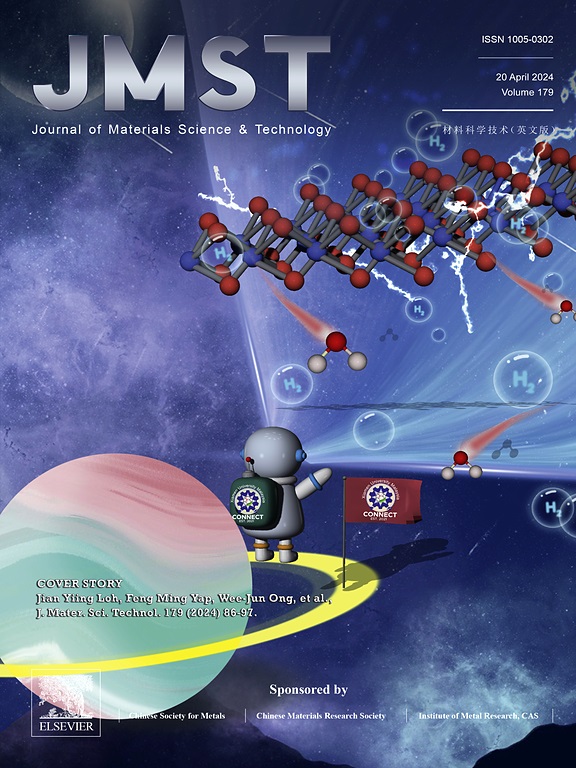Evolution mechanism of Ni3Si precipitate and anisotropic Frank loop variation in Ni-based alloy revealed by proton irradiation and MD simulations
IF 11.2
1区 材料科学
Q1 MATERIALS SCIENCE, MULTIDISCIPLINARY
引用次数: 0
Abstract
Proton irradiation with a low damage rate was conducted on the Ni-based alloy GH3535 to investigate the evolution behavior of dislocation loops and irradiation-induced segregation (RIS), both of which are known to degrade mechanical properties. This study identified that RIS induced the nucleation of Ni₃Si precipitates from Ni-Si clusters in the irradiated Ni-based alloys, which is considered a significant contributor to irradiation hardening in stainless steel. Atomic probe tomography (APT) analysis revealed Ni enrichment on both sides of the dislocation loop edges, forming a "W-shaped" profile. Meanwhile, Si accumulated along the edge, inhibiting loop growth and leading to the formation of shadows. Molecular dynamics (MD) simulations confirmed the mechanism of this enrichment distribution. With increasing irradiation dose, Ni₃Si nucleates at loop edges and coarsens by absorbing nearby Si atoms, ultimately resulting in the dissolution of the loop. This RIS at dislocation loops results in a Si-depleted matrix, stabilizing the nucleation of CrMo-enriched M₂C carbides and newly formed Frank loops. Meanwhile, four Frank loop (FL) variants were found to have anisotropic behavior. Scanning transmission electron microscopy (STEM) characterization across several crystal orientations revealed that the highest density of Frank loops occurred in the variant perpendicular to the crystal orientation. MD simulations indicated a distinct increase in the formation energy of the four variants under compressive stress, highlighting the influence of stress from ion penetration on Frank loop nucleation. These findings provide valuable insights into the evolution of precipitates and quantitative analysis of dislocation loops in Ni-based alloys.

质子辐照和MD模拟揭示了ni基合金中Ni3Si析出物的演化机理和各向异性Frank环的变化
对ni基合金GH3535进行了低损伤率质子辐照,研究了位错环和辐照诱导偏析(RIS)的演化行为,这两种现象都会降低合金的力学性能。该研究发现,RIS诱导辐照镍基合金中Ni-Si团簇的Ni₃Si析出物成核,这被认为是不锈钢辐照硬化的重要因素。原子探针断层扫描(APT)分析显示,Ni富集在位错环边缘两侧,形成“w”形轮廓。同时,Si沿着边缘积累,抑制了环路的生长,导致阴影的形成。分子动力学(MD)模拟证实了这种富集分布的机理。随着辐照剂量的增加,Ni₃Si在环的边缘成核,并通过吸收附近的Si原子而变粗,最终导致环的溶解。这种位错环上的RIS导致了一个缺si的基体,稳定了富crmo的M₂C碳化物的形核和新形成的Frank环。同时,发现四个Frank loop (FL)变体具有各向异性行为。扫描透射电子显微镜(STEM)在多个晶体取向上的表征表明,Frank环密度最高的是垂直于晶体取向的变体。MD模拟表明,在压缩应力作用下,四种变体的形成能明显增加,突出了离子渗透应力对Frank环成核的影响。这些发现为ni基合金中析出相的演变和位错环的定量分析提供了有价值的见解。
本文章由计算机程序翻译,如有差异,请以英文原文为准。
求助全文
约1分钟内获得全文
求助全文
来源期刊

Journal of Materials Science & Technology
工程技术-材料科学:综合
CiteScore
20.00
自引率
11.00%
发文量
995
审稿时长
13 days
期刊介绍:
Journal of Materials Science & Technology strives to promote global collaboration in the field of materials science and technology. It primarily publishes original research papers, invited review articles, letters, research notes, and summaries of scientific achievements. The journal covers a wide range of materials science and technology topics, including metallic materials, inorganic nonmetallic materials, and composite materials.
 求助内容:
求助内容: 应助结果提醒方式:
应助结果提醒方式:


